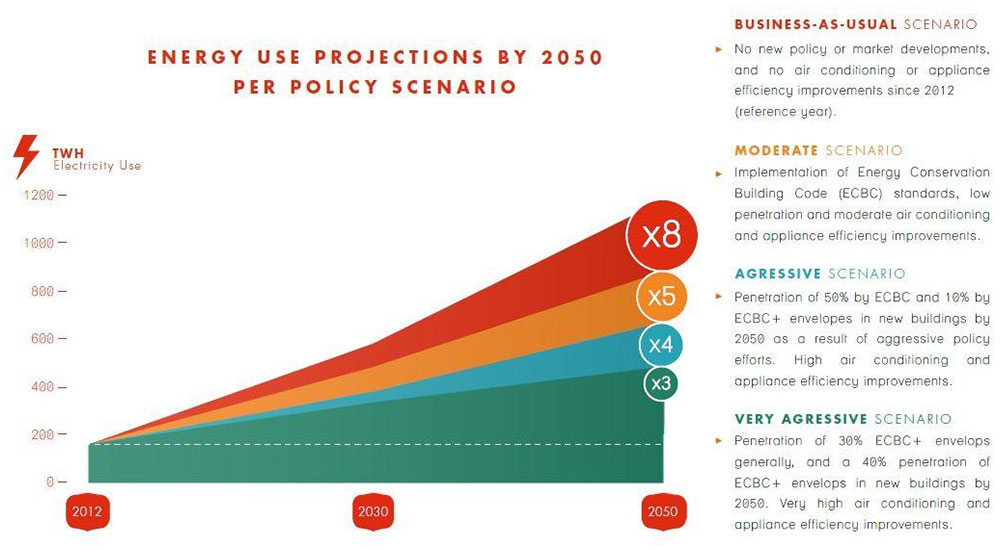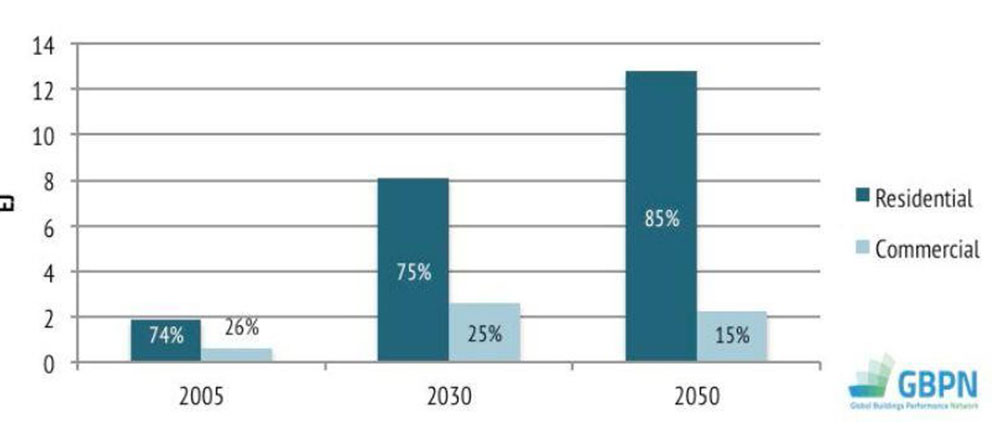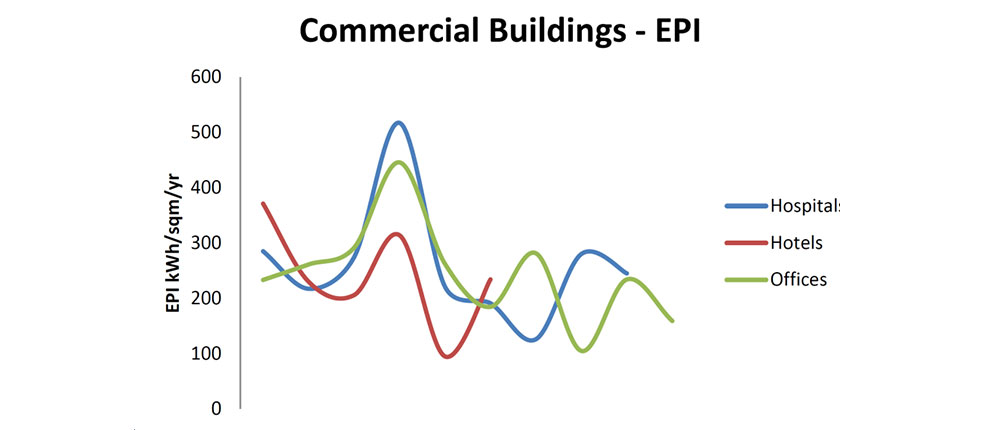Buildings are energy guzzlers
India is facing formidable challenges in meeting its energy needs. Domestic and commercial building sectors account for approximately one-third of total electricity consumption and these sectors are likely to consume around 37% of electricity in 2020-21. The commercial buildings sector which comprises office buildings, hotels, hospitals, educational institutes, retails malls, etc., consumes 9% of total electricity consumption in India. This sector has experienced electricity consumption growth rate of 12-14% in recent years, which is attributed to the increased electricity consumption in the existing buildings as well as increasing energy intensity of newly constructed commercial buildings. Further, construction is taking place at a rapid pace. India is yet to build nearly two-third of its 2030 building stock, according to a report by McKinsey & Company. This presents a huge opportunity to conserve energy in this sphere.

The above projection scenarios indicate that electricity consumption is predicted to rise by more than eight times under the business-as-usual scenario. Using focused policy and market efforts, and moderate, aggressive and very aggressive strategies can limit the consumption increase to five times, four times and three times of the current energy usage, respectively.

Although the residential sector consumes a major part of electricity, commercial buildings have greater opportunity to conserve energy as they are more energy intensive and are usually dominated by internal loads. The main focus of this study is on commercial buildings consisting of hospitals, hotels and offices. In order to reduce the ever increasing gap between energy supply and demand, energy efficiency in existing buildings is of prime importance. The opportunities for improvements in energy performance are not readily recognized by public in general. This is one of the main motives behind establishing the UTC- TERI Centre of Excellence.
The UTC-TERI Centre of Excellence (CoE)
Keeping in mind the energy consumption in commercial building sector, ‘UTC-TERI Centre of Excellence (CoE) for energy efficient existing buildings in India’ has been set up by The Energy and Resources Institute (TERI) and United Technologies Corporation (UTC). The CoE has been set up to understand the current energy consumption trends in existing buildings, identify opportunities for saving energy and to identify and bridge gaps (technical and financial) in implementation of energy saving solutions.
Main objectives of setting up Centre of Excellence include: (i) development of energy use reporting framework for the existing building sector; (ii) real time reporting of energy consumption and identification and cost benefit analysis of energy conservation measures; (iii) development of Measurement and Verification (M&V) protocol for establishing the energy saving potential of various energy conservation measures; and (iv) development of supportive standards, policies and regulations that will enable market uptake of energy-efficient technologies.
Approach
The scope of work includes the energy survey of 84 commercial building spaces selected across four Indian climatic zones over a period of five years. Parallel studies are being conducted to understand the energy use pattern/energy intensity and energy consumption of the varied typologies of commercial buildings in India. A team consisting of TERI and UTC professionals conducted energy audits where data was monitored and recorded. Following each audit a comprehensive report on the findings and suggestions/recommendations were submitted to the client. An overall guidance on the activity is being provided by an executive committee consisting of experts from UTC and TERI organizations.
What gets measured gets managed
This is the underlying principle of this study. Data collection helps manage buildings effectively and facilitate energy accounting. The data collected primarily helps to identify energy conservation measures (ECMs) for low performing buildings, and help to quantify/verify energy savings.
Emphasis is placed on the rigour of the process of field data collection and data requirements to perform energy analysis and maintain high quality of energy audits. This helps to make informed decisions about the feasibility of retrofit upgrades.
The data collected from the client during the audit consists of electricity bills (for a period of three years), lighting inventory, AHU inventory, HVAC design data, chiller, LT panel, and transformer logbook data. State-of-art technology instruments are used for data collection during the energy audit of the buildings. The building facilities depend majorly on meters installed on electrical panels and readings from chiller panels to obtain needful information. They do not utilize any special equipment for energy data collection. The instrumentation used by our team for measurement of data on site include one phase and three phase power analyzer, lux meter, ultrasonic flow meter, anemometer, thermo hygrometer and thermal imager etc.

The energy consumed by buildings under the three typologies varies in each case. EPI of hospital buildings is in the range of 126-517 kWh/m2/yr, EPI of hotels is 95-371 kWh/m2/yr and office buildings in the range of 105-446 kWh/m2/yr. The average EPI calculated for hospital buildings is 262 kWh/m2/yr, while the average EPI for hotel and office buildings is 242 kWh/m2/yr and 246 kWh/m2/yr, respectively.
Identification of Energy Conservation Measures
Appropriate Energy Conservation Measures (ECMs) have been identified for each building audited with an aim to reduce the consumption of energy. ECMs suggested include variable operation of secondary chilled water pump, installation of chiller plant optimizer, replacement of standard efficiency motors, retrofitting existing single loop constant pump, replacing existing chillers, replacement of existing unitary ACs, packaged ACs with variable refrigeration volume systems, installation of adiabatic cooling pads in existing air cooled chillers, replacement of existing lighting fixtures with LED fixtures and replacement of chilled water pumps and condenser water pumps etc. The ECMs are applied based on feasibility and profitability of the scheme for each building. A simple payback period analysis was carried out for the ECMs applied in each building. By assessing direct energy and cost savings from the energy efficient technologies or measures the payback periods were in a promising range of 0.6-5 years.
Challenges in implementation of ECMs
After energy conservation measures have been appraised, the next step is to implement these measures in the building. Some of the major challenges involved are as follows:
- The entire focus should be shifted from the level of the facility manager to the board room where the decision making takes place. Herein lies the first challenge of enabling a smooth communication between the board room and the facility manager.
- A lack of a comprehensive view in implementation of the energy saving measures. A holistic approach is needed to achieve the deemed savings.
The electricity tariffs are continuously increasing, and hence there is an undeniable need to improve energy efficiencies of building systems.
Financing methods
Several methods of financing energy efficiency measures exist, including internal funding, debt funding, lease, energy performance contracts (ESCOs), utility incentives, equipment rebates etc. Internal funds are direct allocations from an organization’s own internal capital or operating budget for ECM implementation. Debt financing is using capital borrowed directly by organization from private lenders and include multiple bonds. Lease purchase agreement is funding through an operating or financial lease of 5- 10 years with no up-front cost. Under energy performance contract, ESCOs provide a service package that includes design and engineering, financing, installation and maintenance of retrofit measures to improve energy efficiency. Utility incentives are rebates, grants, or other financial assistance offered by an energy utility for the design and purchase of certain energy-efficient systems and equipment usually as a result of the implementation of a policy to promote energy efficiency. Equipment rebates involve rebates on the initial purchase price of selected energy-efficient equipment.1 Thus, several methods of ECM implementation and some with the inclusion of policy are possible.
Enhancing the energy efficiency of the building stock is an important part of achieving cost reductions at the building owner-tenant level and also of any national level energy or climate policy. This requires a thorough understanding of building energy consumption patterns. A reliable and robust energy data framework to quantify energy consumption and production benefits the government tremendously. A robust program that has technical and statistical rigor, collects parameters relevant to energy use in commercial buildings and produces results in an effective manner is needed. This will enable enhancing of energy efficiency and evidence based effective building energy efficiency policy making in India. The study will be carried forward with these goals in mind. We hope that this study helps in taking the implementation of ECMs to the next level and makes the change we want to see. Thus, it helps ratify the active involvement of the board room while highlighting these measures.
The recommendations offered following energy audits are often not implemented due to the reason that electricity bills are a small area in the context of an organization. However, we need to look at the big picture and consider the fact that electricity prices are not stagnant and are recurring. We must manage what is measured before the problem gets out of bounds, at an early stage itself. Organizations that implement these changes are at an advantage and perform well in the future.
1. Module 18, Energy efficiency in buildings
